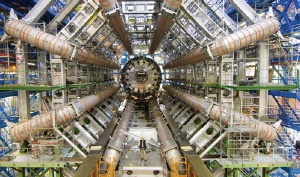Aug 21 2008
September 2008 will see particle physicists setting protons on a collision course through the Large Hadron Collider with more energy than ever before. Their intention is to track down the Higgs boson and solve the problem of why the universe contains almost no antimatter. Physicists from the Max Planck Institute for Physics and the Max Planck Institute for Nuclear Physics are playing a crucial role in the experiments and their preparation.
 Higgs bosons will be caught in the ATLAS detector’s net with its eight magnetic coils. Photo: CERN Geneva
Higgs bosons will be caught in the ATLAS detector’s net with its eight magnetic coils. Photo: CERN Geneva
It’ll be completely obvious that this photo is a set-up,” protested Siegfried Bethke, Director at the Max Planck Institute for Physics, resisting the suggestion that he pose in front of the diverter magnet of the Large Hadron Collider. “Normally, no one ever turns up to work here wearing a tie.” It’s true: 100 meters below ground, there are no ties or suits to be seen. Currently, work to finish the Large Hadron Collider, or LHC, the largest storage ring in the world, at the European Research Center for Particle Physics (CERN) near Geneva, is progressing at full speed.
Elevators continually transport groups of physicists and technicians down to the measuring devices, where they put the finishing touches on the cabling. Workers with climbing gear and wearing safety harnesses pull themselves precariously up and down the ATLAS detector, which rises as high and almost as wide as a ten-story apartment block above the accelerator pipe. Workmen carry out precision work on difficult-to-access parts between the apparatus. Mobile cranes lift platforms with other specialists up to adjust the beam pipe. “I’m happy to say that we’re only two months behind schedule at the moment,” says physicist Michael Hauschild. “That’s nothing at all in a project of this size.”
With an investment of four billion euros, 24 years of planning, development and construction, and around 7,000 employees, the LHC is one of the largest research projects that the world has ever taken on. In the four underground caves that contain the large-scale experiments, physicists want to uncover the secret of why matter exists and how it came about.
A Miniature Big Bang
To do this, they will send two beams of protons at approximately the speed of light through a 27-kilometer ring-shaped tunnel and allow them to crash into each other in the center of detectors that can be up to 25 meters high. Hauschild gives a vivid illustration of the scale: “The energy that is concentrated in a tiny volume is equivalent to that of two elephant herds, each with 120 members, running toward each other at top speed in the savanna. Obviously, this is an encounter that will raise a lot of dust.”
The result of these collisions in the accelerator can well be called a mini Big Bang – which is exactly what the researchers want. They want to reproduce in miniature what happened when the world was created: “We are looking, as it were, for dinosaur particles from the prehistory of the universe,” explains CERN physicist Rolf Landua, Head of the Education Group. The detectors capture any new particles that are created in the collision, register their direction, charge and energy, and the physicists hope for new findings from this data.
Particle physicists will be moving into unknown territory in their field. And two Max Planck institutes will be among them: the Max Planck Institute for Physics in Munich is involved in three systems in the ATLAS detector, and the Max Planck Institute for Nuclear Physics in Heidelberg is working on the LHCb experiment. “It’s a foregone conclusion that we should be working on this international project,” says Siegfried Bethke. “After all, we are continuing the research work that Werner Heisenberg started at our institute.” Furthermore, in his view, the project could not manage without the experience of Munich-based Max Planck researchers in developing innovative particle detectors.